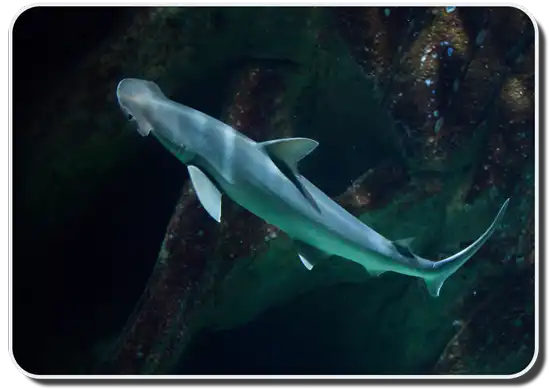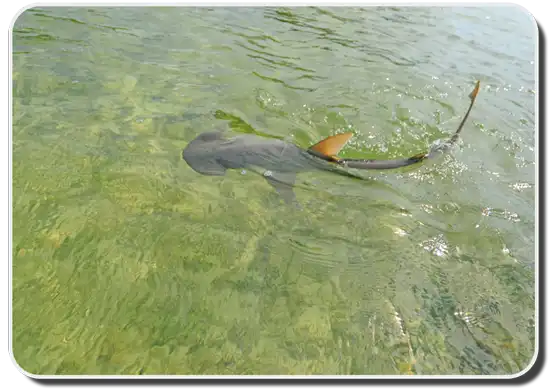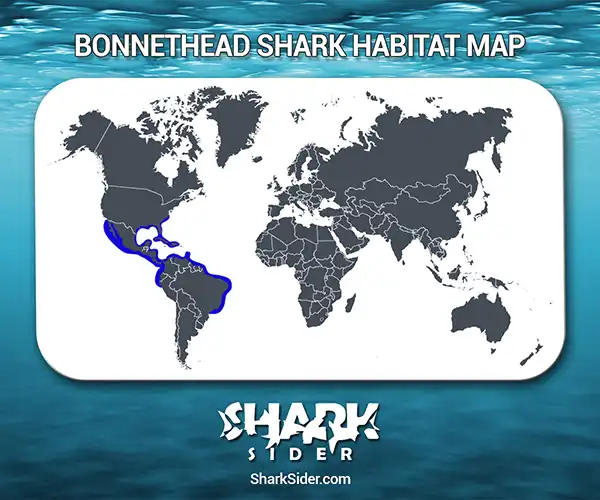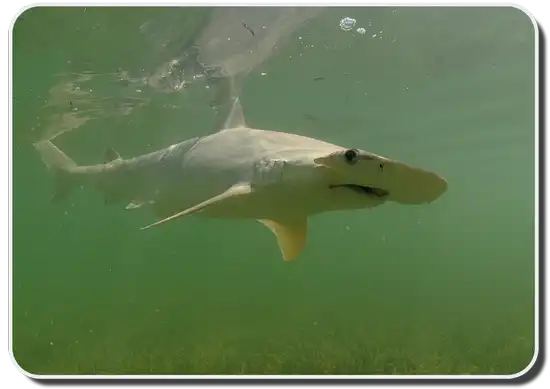The bonnethead shark is the smallest hammerhead shark that has several unique traits that help it to stand out. These include having distinct differences between genders, an omnivorous diet, and keeping in touch with other bonnetheads via cerebral secretions.
These sharks are also popular for their meat, which has a mild taste.

Bonnethead Shark Scientific Classification |
|
| Kingdom | Animalia |
| Phylum | Chordata |
| Class | Chondrichthyes |
| Order | Carcharhiniformes |
| Family | Sphyrnidae |
| Genus | Sphyrna |
| Scientific Name | S. tiburo |
Description
The bonnethead shark is the smallest of all ten hammerhead species, only reaching lengths of 2.6–3.0 ft on average and 4.9 ft at most. Their cephalofoils – or, as they are referred to colloquially, hammerheads – are broad and smooth, resembling a spade, earning them the nickname “shovelhead”. It is pretty easy to distinguish between the two sexes – the male has a bulge on the top of their cephalofoils which is absent in the females, who have a broad, round head.
These are also the smallest of hammerheads, so small that they are the only hammerhead shark to rely on their pectoral fins to swim as their cepahlofoils are too small to pitch with like other members of the genus.
Dorsally these sharks are a greyish brown, with their ventral region being white, making them almost invisible when spotted from above and below.
These sharks have teeth meant to feed on hard and soft prey – smaller ones in front for grabbing and larger molars in the back to crush shells.
 Where do they live
Where do they live
Map Of The Bonnethead Shark’s Habitat

These sharks live in both the Atlantic and Pacific Oceans. Their range is from New England to the Gulf of Mexico and Brazil on the Atlantic side, while in the Pacific Ocean, they are found from southern California to northern Peru.
They prefer shallow waters of estuaries and bays, living close to corals, reefs, and the sandy ocean floor.
Behavior
Dietary
These sharks feed on creatures dwelling on the seafloor, which mainly includes crustaceans like blue crabs. Most notably, a good portion of their diet consists of seagrass, making them one of the few omnivorous sharks that aren’t filter feeders. Experts assume the shark does this to protect its stomach lining from the spine-covered carapaces of the blue crabs.
Their diet also includes mollusks, shrimps, and small fish.
Predatory
Like other hammerhead sharks, the bonnethead uses its head to detect electromagnetic fields of prey on the ocean floor. Once it discovers something, it bites down hard, with its teeth strong enough to break the shell of even a blue crab.
Social
These sharks swim in groups of 3-15, though schools of over a thousand members have also been reported.
Reproductive
As viviparous sharks, they give live birth. After a gestation period of around 4.5-5 months, which is short for most sharks, they give birth to 4-12 pups around late summer to early fall. The newly born bonnetheads are 12-13 inches long.
 There was an interesting instance of a female bonnethead shark giving birth via parthenogenesis, i.e., she gave birth asexually as there were no males in the same tank as her. It occurred in captivity at the Henry Doorly Zoo in Nebraska.
There was an interesting instance of a female bonnethead shark giving birth via parthenogenesis, i.e., she gave birth asexually as there were no males in the same tank as her. It occurred in captivity at the Henry Doorly Zoo in Nebraska.
Adaptations
The bonnethead shark has a unique way of communicating with other members of its species – they release a cerebrospinal fluid to inform others of its location.
Interactions with humans
These sharks are shy, not attacking or biting, and avoiding human contact if possible.
The bonnethead shark used to be classified as “Least Concern” or “LC” until 2020, when its numbers dropped to the point where the IUCN classified it as “EN” or “Endangered”. The reason for this is commercial and recreational fishing, causing it to disappear from several areas of its former habitat, including the Caribbean Sea.
